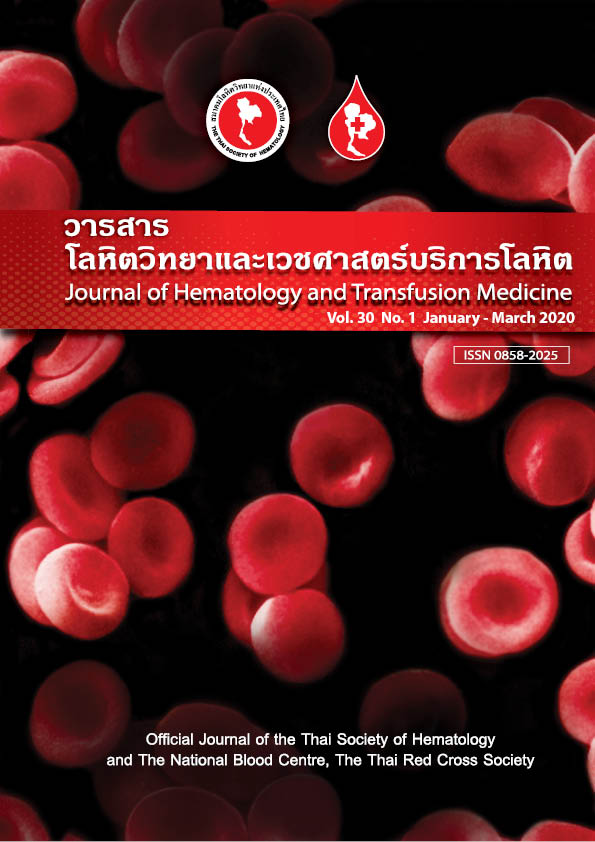การศึกษาประสิทธิภาพและความปลอดภัยของการทำ therapeutic leukapheresis ให้ผู้ป่วยมะเร็งเม็ดเลือดขาวในโรงพยาบาลสงขลานครินทร์
Keywords:
Leukemia, Hyperleukocytosis, Therapeutic leukapheresisAbstract
บทคัดย่อ
บทนำ ผู้ป่วยมะเร็งเม็ดเลือดขาวที่มีภาวะ hyperleukocytosis อาจเสียชีวิตจากภาวะเลือดหนืดหรือจากการคั่งของเม็ดเลือดขาวในอวัยวะสำคัญ ซึ่ง American Society for Apheresis (ASFA) จัดผู้ป่วยกลุ่มนี้ว่ามีข้อบ่งชี้ที่ควรได้รับการรักษาด้วย therapeutic leukapheresis (TLP) วัตถุประสงค์ เพื่อศึกษาประสิทธิภาพของการทำ TLP ในการลดจำนวนเม็ดเลือดขาว ฮีโมโกลบิน และเกล็ดเลือดของผู้ป่วย ศึกษาความปลอดภัยจากอาการไม่พึงประสงค์ที่เกิดขึ้นและจำนวนผู้เสียชีวิต วัสดุและวิธีการ ศึกษาข้อมูลย้อนหลังจากการทำ TLP ในโรงพยาบาลสงขลานครินทร์ตั้งแต่เดือนกุมภาพันธ์ พ.ศ. 2552 ถึง กุมภาพันธ์ พ.ศ. 2562 โดยให้เม็ดเลือดขาวเหลือน้อยกว่า 100 x 109 /L รายงานจำนวนเม็ดเลือดขาว ฮีโมโกลบิน และเกล็ดเลือดที่เปลี่ยนแปลง อาการไม่พึงประสงค์และจำนวนผู้เสียชีวิตภายใน 30 วันหลังทำ ผลการศึกษา มีการทำ TLP ในผู้ป่วยมะเร็งเม็ดเลือดขาวจำนวน 77 ราย เป็น AML 39 ราย (ร้อยละ 50.6) ALL 28 ราย (ร้อยละ 36.4) และ CML 10 ราย (ร้อยละ 13) โดยได้รับการทำ TLP 180 ครั้ง เฉลี่ยรายละ 2.3 ครั้ง (1-5 ครั้ง) ก่อนทำผู้ป่วย AML ALL และ CML มีเม็ดเลือดขาวเฉลี่ย 276.7 ± 141.6 x 109 /L, 398.4 ± 221.8 x 109 /L และ 397 ± 199.4 x 109 /L ตามลำดับ หลังทำมีเม็ดเลือดขาวเฉลี่ย 129.7 ± 95.6 x 109 /L, 195.9 ± 149.7 x 109 /L และ 198.9 ± 131.6 x 109 ตามลำดับ ลดลงร้อยละ 53.1 ร้อยละ 50.8 และร้อยละ 50.0 ตามลำดับ พบว่าสามารถลดจำนวนเม็ดเลือดขาวลงได้อย่างมีนัยสำคัญ (p < 0.05) ในขณะที่ปริมาณฮีโมโกลบินและเกล็ดเลือดไม่ลดลงอย่างมีนัยสำคัญ เนื่องจากผู้ป่วยบางรายที่มีภาวะซีดจะได้รับ leukocyte depleted packed red cells ในขั้นตอนการเตรียมเครื่องหรือในระหว่างทำร่วมด้วยและผู้ป่วยเกล็ดเลือดต่ำร่วมกับมีภาวะเลือดออกจะได้รับ leukocyte depleted platelets พบอาการไม่พึงประสงค์เกิดขึ้นระหว่างทำ 34 ครั้ง (ร้อยละ 18.9) ส่วนมากเป็นอาการเล็กน้อยที่เกิดจากภาวะแคลเซียมในเลือดต่ำ และไม่พบอาการรุนแรงจนเสียชีวิตขณะทำ มีผู้ป่วยเสียชีวิตหลังทำทั้งหมด 28 ราย (ร้อยละ 36.4) เสียชีวิตหลังทำภายใน 30 วัน 25 ราย (ร้อยละ 32.5) และเสียชีวิตหลังทำมากกว่า 30 วัน 3 ราย (ร้อยละ 3.9) สรุป protocol ที่ใช้มีประสิทธิภาพในการลดจำนวนเม็ดเลือดขาวและมีความปลอดภัยต่อผู้ป่วย ไม่พบอาการไม่พึงประสงค์ที่รุนแรง แต่ไม่สามารถลดอัตราการตายภายใน 30 วันลงได้ในกลุ่มผู้ป่วย AML และ ALL ที่มีพยากรณ์โรคไม่ดี
Abstract:
Introduction: Hyperleukocytosis in leukemic patients is associated with early mortality, due to either leukostasis or hyperviscosity syndrome. According to the American Society for Apheresis (ASFA) guidelines; therapeutic leukapheresis belongs to indication of category II, which is considered to be appropriate and acceptable. Objective: To analyze both the efficacy and safety of the protocol used for therapeutic leukapheresis. Materials and methods: We performed a retrospective study of leukemic patients with hyperleukocytosis, who underwent therapeutic leukapheresis, in Songklanagarind hospital, during February 2009 to February 2019. The procedures were performed until their white blood cells (WBC) level was reduced to lower than 100 x 109 /L. Both percent and absolute reductions of WBC, hemoglobin and platelet were calculated. Moreover, frequency of adverse effects during the procedures along with early mortality rate were observed. Results: Seventy seven patients, including 39 AML (50.6%), 28 ALL (36.4%) and 10 CML (13.0%), underwent 180 therapeutic leukapheresis procedures. The mean number of procedures per patient was 2.3 (range 1-5). The mean values ± SD of initial WBC were 276.7 ± 141.6 x 109 /L, 398.4 ± 221.8 x 109 /L and 397 ± 199.4 x 109 /L for AML, ALL and CML, respectively. The average WBC reductions (percentage) after the procedures were 129.7 ± 95.6 x 109 /L (53.1%), 195.9 ± 149.7 x 109 /L (50.8%) and 198.9 ± 131.6 x 109 (50.0%) for AML, ALL and CML, respectively. There was a significant decrease in the WBC count after leukapheresis, as compared with the baseline value (p < 0.05), and while both hemoglobin and platelet counts changed were not statistically significant differences (p > 0.05). Although, there were side effects in 34 of the 180 (18.9%) performed procedures, most reactions were mild; due to hypocalcemia. There were no patients developed any serious complications related to leukapheresis. The total mortality rate was 36.4%, whilst 32.5% died within 30 days. Conclusion: The standard protocol used for therapeutic leukapheresis is a safe and effective procedure, for leukoreductions in leukemic patients with hyperleukocytosis. However, we observed a high early mortality rate in poor prognostic patients, especially in AML and ALL patients.
Downloads
References
2. Korkmaz S. The management of hyperleukocytosis in 2017: Do we still need leukapheresis? Transfus Apher Sci. 2018;57:4-7.
3. Ganzel C, Becker J, Mintz PD, Lazarus HM, Rowe JM. Hyperleukocytosis, leukostasis and leukapheresis: practice management. Blood Rev. 2012;26:117-22.
4. Choi MH , Choe YH, Park Y, Nah H, Kim S, Jeong SH, et al. The effect of therapeutic leukapheresis on early complications and outcomes in patients with acute leukemia and
hyperleukocytosis: a propensity score-matched study. Tansfusion. 2018;58:208-16.
5. Ingrid M. Salinas P, Victoria P, Rodriguez G, José A. Erce G. Therapeutic leukapheresis: 9-year experience in a University Hospital. Blood Transfus. 2015;13:46-52.
6. Schwartz J, Padmanabhan A, Aqui N, Rasheed. A guidelines on the use of therapeutic apheresis. J Clin Apher. 2016;31:149-62.
7. PadmanabhanA , Smith LC, Aqui N, Balogun RA, Klingel R, MeyerE, et al. Guidelines on the use of therapeutic apheresis in clinicalp–evidence-based approach from the writing committee of the American Society for Apheresis: The eighth special issue. J Clin Apher. 2019;34:171-354.
8. Davenport RD. Therapeutic apheresis. In: Fung MK, Grossman BJ, Hillyer CD, Westhoff CM, eds. Technical manual. 18th ed. Bethesda, MD : American Association of Blood Banks, 2014:645-64.
9. Yavasoglu I, Kadikoylu G, Akyol A, Bolaman Z. Therapeutic apheresis: results from a single center in Turkey. Transfus Apher Sci. 2007;36:249-253
10. Berber I, Kuku I, Erkurt MA, Kaya E, Bag HG, Nizam I, et al. Leukapheresis in acute myeloid leukemia patients with hyperleukocytosis: A single center experience. Transfus Apher Sci. 2015;53:185-90.
11. Tan D, Hwang W, Goh YT. Therapeutic leukapheresis in hyperleukocytic leukaemias - The experience of a tertiary institution in Singapore. Ann Acad Med Singap. 2005 34:229-34.
12. NanX, Qin Q, Gentille C, Ensor J, Leveque C, Pingali SR, et al. Leukapheresis reduces 4-week mortality in acute myeloid leukemia patients with hyperleukocytosis–a retrospective study from a tertiary center. Leukemia Lymphoma. 2017;58:1-11.
13. Yilmaz D, Karapinar B, Karadas N, Duyu M, Yazici P, Ay Y. Leukapheresis in childhood acute leukemias: single-center experience. J Pediatr Hematol Oncol. 2014;31:318-26.
14. Blum W, Porcu P. Therapeutic apheresis in hyperleukocytosis and hyperviscosity syndrome. Semin Thromb Hemost. 2007;33:350-4.
15. Haase R, Merkel N, Diwan O, Elsner K, Kramm CM. Leukapheresis and exchange transfusion in children with acute leukemia and hyperleukocytosis. A single center experience. Klin Padiatr. 2009;221:374-8.
16. Nagase K, Sawada K, Ohnishi K, Egashira A, Ohkusu K, Shimoyama T. Complications of leukocytapheresis. Therapeutic Apheresis. 1998;2:120-4.
17. Ganzel C, Becker J, Mintz PD, Lazarus HM, Rowe JM. Hyperleukocytosis, leukostasis and leukapheresis: practice management. Blood Rev. 2012;26:117-22.



